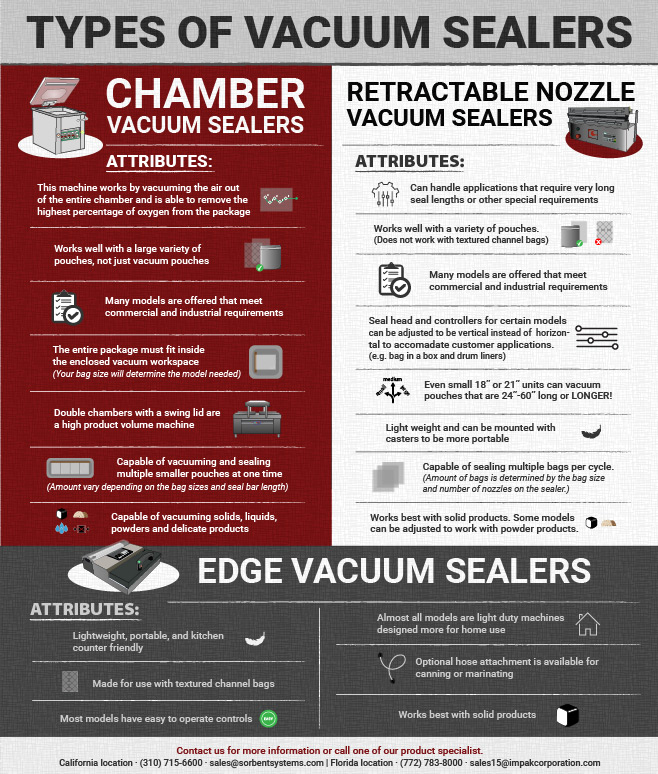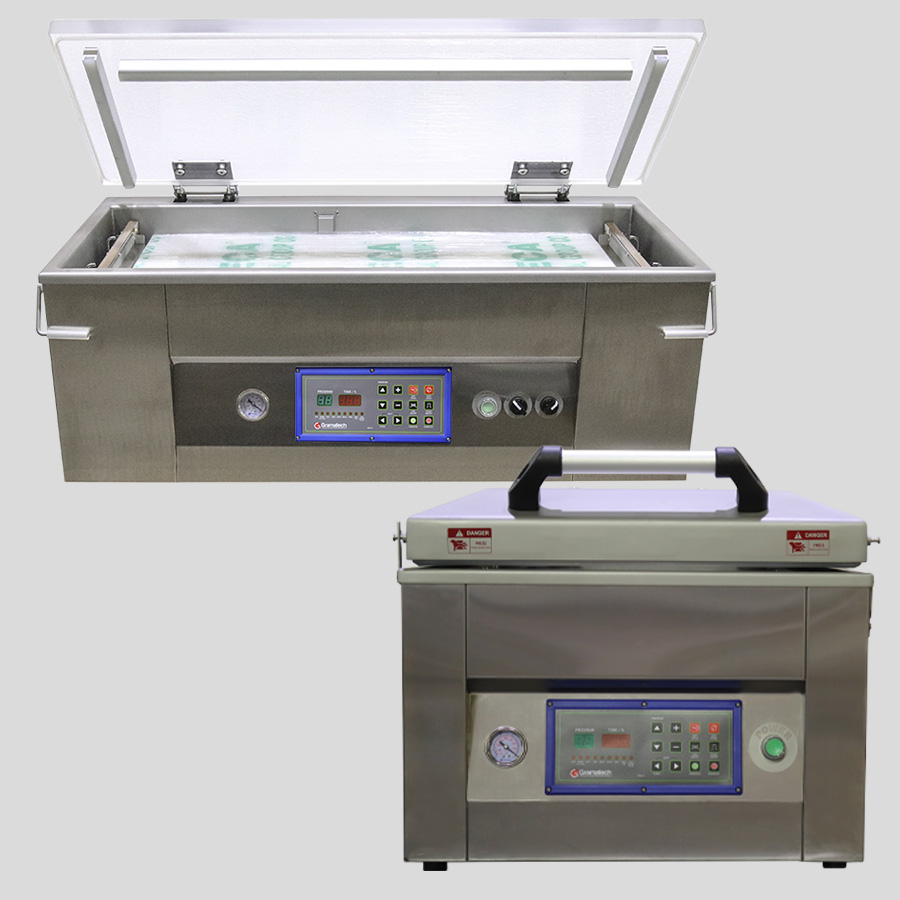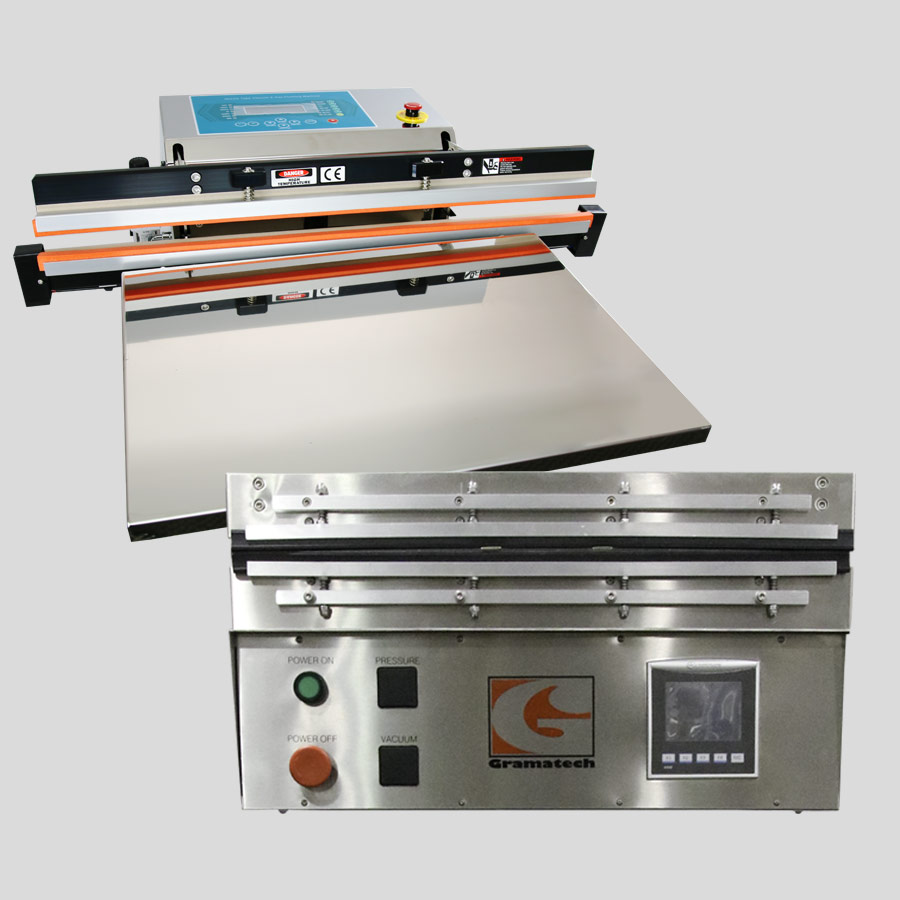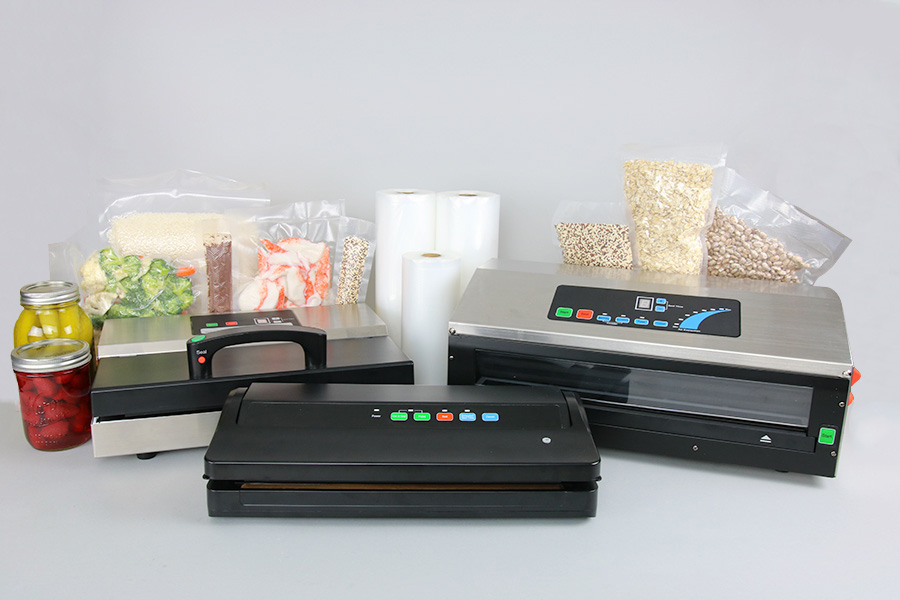These are machines where all the vacuum and sealing of the package takes place within a fully enclosed work area. In most cases the package is placed within the enclosed work area the lid is then closed and the balance of the operation takes place automatically.
Like the other external clamp vacuum sealers these machines work by pulling a vacuum directly out of the vacuum pouch with no need for an enclosed work area. However, these units utilize a vacuum nozzle that protrudes into the pouch during the vacuum cycle and then automatically retracts from inside the pouch at the end of the vacuum cycle.
These machines utilize a small vacuum cavity located in the seal jaw area of the machine to provide a source of vacuum flow that evacuates to air directly from inside the pouch via special channels that are part of the vacuum pouch. The most well know brand of this type of vacuum sealer are the FoodSaver™ machines.

For more detailed information on how to choose the right vacuum sealer for your application please contact us or click here
A decision has been made that your product needs to be vacuum packaged in order to prevent spoilage, oxidation or some other adverse condition caused be oxygen left inside the package. With this decision made the next step is to evaluate the vacuum packaging systems on the market and choose the type that meets your specific needs the best. Even a small amount of research will show you that there are two major types of vacuum sealing machines on the market and those are chamber type units where your entire package must be placed inside the vacuum cavity area of the machine and non-chamber type machines that fall into two sub-categories. Non chamber type vacuum sealers can be either nozzle type units or Edge type (Food Saver™) machines that require the use of special bags often referred to as channel or mesh bags. In the discussion below we will go through the pros and cons of each of these machines. For the purposes of the discussion below we will not be including several special types of vacuum packaging machines such as roll stock machines, vacuum skin packaging machines and rotary chamber machines, all used for very high production vacuum packaging. If your product and application require these types of machines, please take the time to contact one of our vacuum packaging specialists to discuss your needs.

Chamber type vacuum sealers are used for a wide variety of both food and non-food products and are among the most versatile vacuum packaging systems on the market. The reason for this is a chamber vacuum sealer can remove more oxygen from the package than most of the other types of vacuum sealers on the market. Therefore, if your product is very sensitive to any residual oxygen that would remain after the packaging process is complete a chamber unit would be the best choice for your application. Chamber machines tend to be more operator friendly as well considering that once your package is placed properly inside the machine and the lid is closed the balance of the cycle happens automatically with no need for manipulating the pouch to help eliminate wrinkles in the seal area that can cause leaks and ultimately rejected packages. On the other hand, chamber units are slower than non-chamber machines if you are doing one package in each unit. However, if your package is a smaller package and several can fit along the sealbar then the longer process time is mitigated by the fact that several packages can be completed in one cycle whereas many non-chamber units can only work with one package per cycle no matter the size as they only have one nozzle and for the models that have two nozzles the operator often finds that placing the packages over each nozzle separately and lining them up properly to get a good quality seal is both time consuming as well as inconvenient.
Chamber type vacuum sealers are available in a variety of models from small tabletop machines to very large double chamber machines. Choosing the correct model for your application is dependent mostly on the size of your package and your throughput requirements. The videos available in the links below may be of some help making that choice.

Nozzle type non-chamber vacuum sealers are normally considered the most commercial type of non-chamber vacuum sealers and are offered in a large variety of models with varying capabilities. Their one common characteristic is the use of a retractable nozzle for eliminating the atmosphere from directly inside the pouch being used to package the product. In all cases the nozzle is inserted into the bag and close to the actual product, it needs to be close to the product to avoid the pouch material collapsing over the nozzle opening and preventing the pouch from being properly evacuated, then once the vacuuming is completed the nozzle is retracted back to a position behind the sealbar and the pouch is then sealed to complete the process. Since this type of system draws the atmosphere directly out of the pouch instead of a vacuum cavity area the pouch is drawn to the contours of the product inside thus putting it under pressure right away. For most products, but not all, being under pressure from the collapsing pouch causes no issues however in some cases this pressure on the pouch can be extreme enough to cause wrinkles in the seal area and this must be avoided by either manual or mechanical means in order to limit rejected packages due to leaks. One of the most important considerations of nozzle type machines is that the size of the package they can handle is only restricted by the seal length of the unit and overall length of the pouch is not a limiting factor. This is an advantage over chamber type vacuum sealers because the entire package must fit inside the vacuum cavity area so the larger the package the larger and more expensive the chamber model must be to accommodate the package.
Many nozzle type vacuum sealers require both a power source as well as a compressed air source. The compressed air is required to operate air cylinders that provide motive power to both the seal jaws, nozzle retraction cylinders and in many cases the venturi system used to generate vacuum flow. However, there are now some nozzle type machines on the market that require only an electrical power source (usually 110V/1PH/60HZ) to operate. These models use electric motor systems to power the seal jaws, nozzle retraction cylinders and to operated small electric vacuum pumps to supply the vacuum flow.

The edge type vacuum sealers are machines that require the use of a special type of vacuum pouch often referred to as a channel bag or a mesh bag. This very fact eliminates their consideration for many packaging applications as these types of bags are not available in a large variety of materials. These types of pouches are also much more expensive that the more common of the regular vacuum pouches. This shortcoming as well as others means that this type of vacuum sealer is most often used as a home use machine to help preserve food from both spoilage and freezer burn as well as a very limited number of commercial applications. The most relevant advantages to this type of vacuum seal are their low cost and ease of operation.
A hermetic seal on flexible packaging can be achieved with any of our sealing machines, this quick guide will help you choose the unit that will work best for your production needs.
Not every Industrial Vacuum Sealer applies to every application. There are different models and types of Vacuum Sealers available, and each one of those sealers has different features that can affect the way a production line works.
We design and manufacture custom sealing equipment to meet the unique needs of our customers. In addition to new machinery we even retrofit our customers’ existing equipment, regardless of the brand.